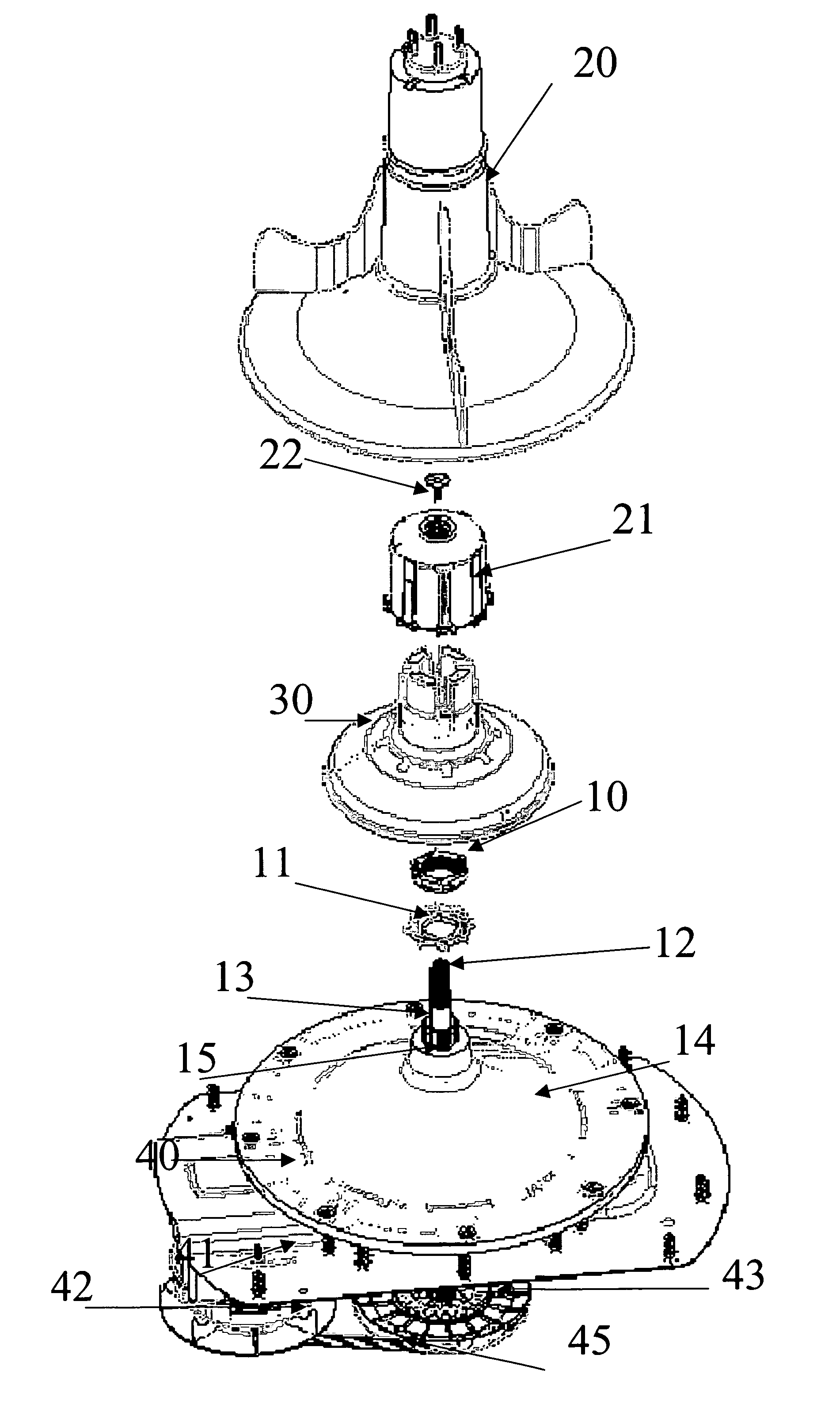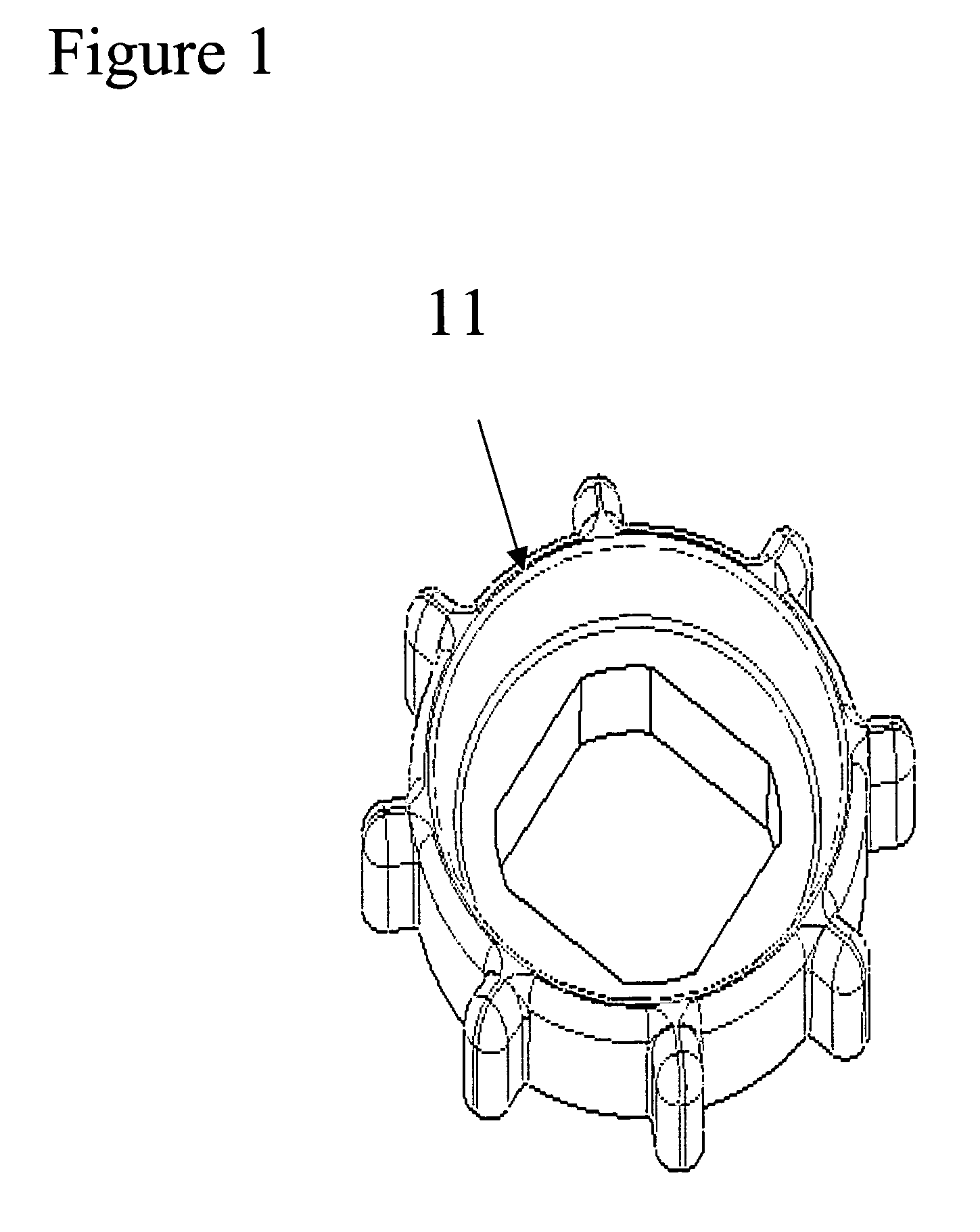However, these clutch systems are far too expensive for simple applications, making it necessary to develop alternatives designs to migrate to lower cost solutions with fewer components, that are easy to manufacture and produce, and stands aggressive or uncommon environments.
In these environments, a friction clutch would not work properly or the specific application requires a different torque level.
There are several approaches to employ similar systems on top loading automatic washing machines as described by the U.S. Pat. No. 2,665,576 to Thiele, it discloses a clutch
system of two fixed gears arranged over a
motor shaft, it
spins at the same speed as the shaft; and a flotation
assembly that includes the
agitator and the basket, a feature that is not very desirable in current top loading domestic washing machines, because this configuration tangles the clothes.
This
system has the inconvenience of not using a pair of concentric shafts, and shows a complicated
system of bands and other clutches in order to carry out the different washing operations.
This situation is additional to the great space that the flotation chambers require to provide lift and move the entire tub including the clothes and the
agitator in the presence of a certain level of water.
This has the
disadvantage of having to raise and lower the basket to engage the clutch, as well as raising the washing basket to be able to spin its contents which, according to the configuration of modern washing machines desirable.
However, this system has a series of drawbacks: The action of the clutch takes place in a wet environment or in contact with water which is associated to the problems described below.
To work correctly, the system needs to drain the basket completely; if the basket is not properly drained, the floating cone will not complete its clutch
stroke.
Another noticeable problem shows on the ribs set at the bottom of the basket, which are ideal places for the buildup of scale, fluff, impurities, and detergent residues, which, in time, could increase the width of the ribs and stop the floating cone from engaging correctly.
Besides, thin or small garments such as handkerchiefs,
socks, diapers, cloth, etc, can be pulled and get stuck under the
agitator aided by the ribs and holes, obstructing the zone where the clutch action takes place, so the floating cone will not be able to engage correctly to the bottom of the basket.
This creates an unhealthy condition because, being in a place that cannot be seen, the user is not aware of all the fluff sediments,
dirt and the clothes that tend to accumulate in the ribs creating a growing media for
bacteria.
The user is unable to remove the impurities because he / she can hardly see them or even imagine this is taking place under the agitator or
propeller; which creates a paradox because washing machines are supposed to be hygienic devices which purpose is to clean clothes or garments that go through a washing cycle inside said devices; the design of a washing
machine should foresee and address these inconveniences and not allow the buildup of foreign objects, fluff, fibers, sediments, scale or
dirt in general.
Therefore, we can conclude that said ribs are undesirable, because they complicate the design and manufacture of the basket, they are not hygienic, they damage the cloths, and they make the system fail after a while.
Additionally, it is evident that the floating cone has serious drawbacks as well; one is the design itself, because by having an open flotation chamber, some lift is lost due to the buildup or adherence of sediments to the
air chamber.
The lift will be poor because, according to our analysis, it will only have enough lift to rise, but it can be assumed that the turbulence present in the zone during the agitation action will cause the floating cone to descend, engaging the tub for
brief periods, due to the decrease of the
air volume inside the
air chamber; which, while open, allows the exchange of
airflow for a liquid flow, this combined with the buildup of scale or sediments in time will increase the weight, which will reduce lift.
So far the invention seems to work properly, but the problem lays in how to obtain a “dry” clutch, which means that the part or parts that perform the clutch action must not be in contact with the water, to prevent foreign objects from housing in there (as was the case with Richardson).
However it allows the buildup of residues, due to the dirt carried by water, water
hardness, high contents of
soap and other chemicals, which over time build up between the jacket of the
propeller and the floating
assembly, thereby preventing a good performance.
This type of foam tends to form or get inside small spaces and, at best, only leaves traces or sediments, but at worst it can stop objects in motion or even support the weight of a light object.
Thus the discussed patent fails to solve this problem by not addressing it properly, because supposing that the user doses the washing liquid with a large amount of
soap and creates the foam described above, the foam will get between the jacket or cover protruding from the center and downward the agitator or
propeller and the center of the floating assembly.
A possible
scenario is that it just builds up sediments, but another
scenario is that the “sudsing” effect is created, preventing the proper operation of the clutch, thus causing an undesirable failure that is difficult to repair.
Another inconvenience of this design is the use of splines, because
machining these splines require a high
degree of precision, since an uncontrolled variation could cause, in a first hypothetical
scenario, a lack of sufficient space between the pieces and a “loose” fitting that is necessary for the system to disengage the clutch without losing any lift, otherwise causing a loss of efficiency and reliability in the operation of the clutch, or a “snuggly” fit (not loose), or in the worst case, a “clenched” fit.
This is critical because when the space between the parts is reduced until they interfere with each other, the system may get stuck and fails.
Another hypothetical scenario is having an assembly that is “loose” beyond tolerated limits, which means that the clearance between them is too much, so, when the torque is transmitted there would not be enough contact surfaces between the faces of the splines, thereby causing mechanical engagement failure, and may even wear the splines.
The use of splines and the little space of the analyzed system can cause friction between its parts, reducing the freedom of motion and reducing lift; also, during the washing cycle there is
evaporation of the water and capillarity.
In the first situation, the evaporated water transports salts from the washing liquor, which adhere to the surface of the spline of the shaft and the spline of the floating assembly, thickening their surface and reducing the clearance, thereby provoking unwanted contact between the parts, increasing the
coefficient of friction, reducing lift or causing the system to stall.
In the second situation, the capillarity can cause buildup of sediments in the clutch zone, the base cylinder and the sheathing (the agitator protrusion), thus affecting the operation of the system.
Also we must point out that the floating assembly is not designed to have a bottom lid that would allow catching air efficiently, permitting the entrance of fluid into the flotation chamber, thus reducing the volume of air inside the chamber and causing a reduction in lift, combined with the possibility of building up sediments or foreign objects, making the floating assembly heavier in time.
Another drawback of this system is located in the seal or O-ring used to connect the propeller to the
motor shaft because it could, in time, allow air leakages and the access of water to the clutch zone or dry chamber, thereby affecting sliding of the pieces because the washing liquid can
rust the splines, increasing the friction between the floating cone and the shaft.
We must point out that when the washing liquid enters the
air chamber it carries
sediment fibers and other undesirable objects into the compartment, causing the system to get stuck and fail.
 Login to View More
Login to View More  Login to View More
Login to View More 


